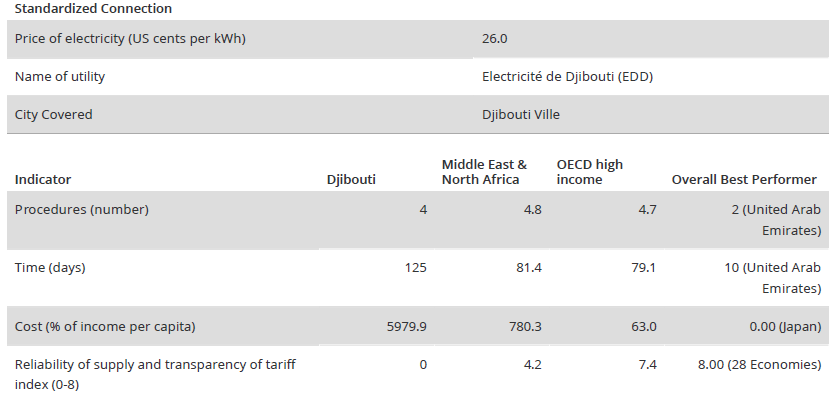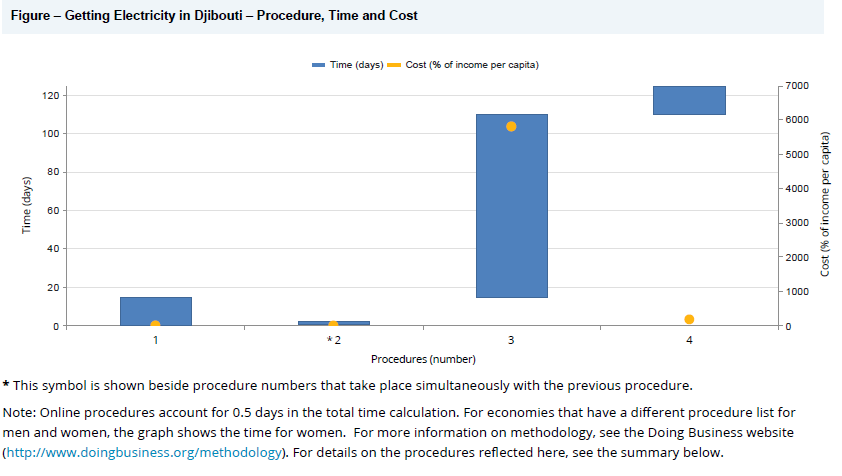Article Index
Getting electricity
Procedures, time and cost to get connected to the electrical grid, the reliability of the electricity supply and the transparency of tariffs
This topic measures the procedures, time and cost required for a business to obtain a permanent electricity connection for a newlyconstructed warehouse. Additionally, the reliability of supply and transparency of tari s index measures reliability of supply,transparency of tari s and the price of electricity. The most recent round of data collection for the project was completed in June2017. See the methodology for more information.
| What the Indicators Measure | Case Study Assumptions |
Procedures to obtain an electricity connection (number)
Time required to complete each procedure (calendar days)
Cost required to complete each procedure (% of income per capita)
The reliability of supply and transparency of tariffs index (0-8)
Price of electricity (cents per kilowatt-hour)*
*Note: Doing Business measures the price of electricity, but it is not included in the distance to frontier score nor the ranking on the ease of getting electricity. |
To make the data comparable across economies, several assumptions are used. The warehouse: The electricity connection: The monthly consumption: |
| Number | Procedures | Time to Complete | Associated Costs |
| 1 | Submit application to Electricité de Djibouti and await estimate Agency : Electricité de Djibouti (EDD) The application is typically submitted to Electricité de Djibouti (EDD) in person. A detailed load schedule should be attached to the application, along with a copy of the construction permit. Once the application is lodged, an engineer from EDD will need to come on site to do a feasibility study. Following this step, the quote will be sent to the customer. |
15 calendar days | DJF 0 |
| >> 2 | Receive external inspection by Electricité de Djibouti Agency : Electricité de Djibouti (EDD) Electricité de Djibouti (EDD) inspects the site and prepares an estimate for the connection fees. |
1 calendar day | DJF 0 |
| 3 | Obtain external works from Electricité de Djibouti Agency : Electricité de Djibouti (EDD) After paying the connection fees, the client needs to wait for Electricité de Djibouti (EDD) to obtain all the material. And for an electricity connection for the warehouse considered in this case study, a unit substation is needed. |
95 calendar days | DJF 19,675,428 |
| 4 | Sign supply contract and obtain meter installation and final connection Agency : Electricité de Djibouti (EDD) When the external works are completed and the client has signed a supply contract, Electricité de Djibouti (EDD) inspects the internal wiring (but not in its entirety) and installs the meter. |
15 calendar days | DJF 604,969 |
>> Takes place simulatenously with the previous procedure.
Details – Getting Electricity in Djibouti – Measure of Quality
| Answer | |
| Reliability of supply and transparency of tariff index (0-8) | 0 |
| Total duration and frequency of outages per customer a year (0-3) | 0 |
| System average interruption duration index (SAIDI) | .. |
| System average interruption frequency index (SAIFI) | .. |
| What is the minimum outage time (in minutes) that the utility considers for the calculation of SAIDI/SAIFI | N/A |
| Mechanisms for monitoring outages (0-1) | 1 |
| Does the distribution utility use automated tools to monitor outages? | Yes |
| Mechanisms for restoring service (0-1) | 1 |
| Does the distribution utility use automated tools to restore service? | Yes |
| Regulatory monitoring (0-1) | 0 |
| Does a regulator—that is, an entity separate from the utility—monitor the utility’s performance onreliability of supply? | No |
| Financial deterrents aimed at limiting outages (0-1) | 0 |
| Does the utility either pay compensation to customers or face fines by the regulator (or both) if outagesexceed a certain cap? | No |
| Communication of tariffs and tariff changes (0-1) | 1 |
| Are effective tariffs available online? | Yes |
| Link to the website, if available online |
http://www.edd.dj/eddweb/upload/tarif_2016.pdf |
| Are customers noti ed of a change in tari ahead of the billing cycle? | Yes |
Note: If the duration and frequency of outages is 100 or less, the economy is eligible to score on the Reliability of supply and transparency of tariff index.
If the duration and frequency of outages is not available, or is over 100, the economy is not eligible to score on the index.
If the minimum outage time considered for SAIDI/SAIFI is over 5 minutes, the economy is not eligible to score on the index.





